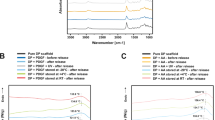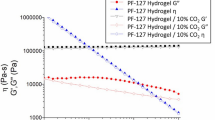Abstract
While delayed delivery of non-steroidal anti-inflammatory drugs (NSAIDs) has been associated with improved tendon healing, early delivery has been associated with impaired healing. Therefore, NSAID use is appropriate only if the dose, timing, and mode of delivery relieves pain but does not impede tissue repair. Because delivery parameters can be controlled using drug-eluting nanofibrous scaffolds, our objective was to develop a scaffold for local controlled release of ibuprofen (IBP), and characterize the release profile and degradation both in vitro and in vivo. We found that when incubated in vitro in saline, scaffolds containing IBP had a linear release profile. However, when implanted subcutaneously in vivo or when incubated in vitro in serum, scaffolds showed a rapid burst release. These data demonstrate that scaffold properties are dependent on the environment in which they are placed and the importance of using serum, rather than saline, for initial in vitro evaluation of biofactor release from biodegradable scaffolds.







Similar content being viewed by others
References
Al Malyan, M., C. Becchi, L. Nikkola, P. Viitanen, S. Boncinelli, F. Chiellini, and N. Ashammakhi. Polymer-based biodegradable drug delivery systems in pain management. J. Craniofac. Surg. 17:302–313, 2006.
Almekinders, L. C., A. J. Baynes, and L. W. Bracey. An in vitro investigation into the effects of repetitive motion and nonsteroidal antiinflammatory medication on human tendon fibroblasts. Am. J. Sports Med. 23:119–123, 1995.
Altman, R. D., L. L. Latta, R. Keer, K. Renfree, F. J. Hornicek, and K. Banovac. Effect of nonsteroidal antiinflammatory drugs on fracture healing: a laboratory study in rats. J. Orthop. Trauma 9:392–400, 1995.
Beason, D. P., B. K. Connizzo, L. M. Dourte, R. L. Mauck, L. J. Soslowsky, D. R. Steinberg, and J. Bernstein. Fiber-aligned polymer scaffolds for rotator cuff repair in a rat model. J. Shoulder Elb. Surg. 21:245–250, 2012.
Bo, J., E. Sudmann, and P. F. Marton. Effect of indomethacin on fracture healing in rats. Acta Orthop. Scand. 47:588–599, 1976.
Bonelli, P., F. M. Tuccillo, A. Federico, M. Napolitano, A. Borrelli, D. Melisi, M. G. Rimoli, R. Palaia, C. Arra, and F. Carinci. Ibuprofen delivered by poly(lactic-co-glycolic acid) (PLGA) nanoparticles to human gastric cancer cells exerts antiproliferative activity at very low concentrations. Int. J. Nanomed. 7:5683–5691, 2012.
Canton, I., R. McKean, M. Charnley, K. A. Blackwood, C. Fiorica, A. J. Ryan, and S. MacNeil. Development of an ibuprofen-releasing biodegradable PLA/PGA electrospun scaffold for tissue regeneration. Biotechnol. Bioeng. 105:396–408, 2010.
Chen, D. W., J. Y. Liao, S. J. Liu, and E. C. Chan. Novel biodegradable sandwich-structured nanofibrous drug-eluting membranes for repair of infected wounds: an in vitro and in vivo study. Int. J. Nanomed. 7:763–771, 2012.
Cohen, D. B., S. Kawamura, J. R. Ehteshami, and S. A. Rodeo. Indomethacin and celecoxib impair rotator cuff tendon-to-bone healing. Am. J. Sports Med. 34:362–369, 2006.
Connizzo, B. K., S. M. Yannascoli, J. J. Tucker, A. C. Caro, C. N. Riggin, R. L. Mauck, L. J. Soslowsky, D. R. Steinberg, and J. Bernstein. The detrimental effects of systemic ibuprofen delivery on tendon healing are time-dependent. Clin. Orthop. Relat. Res. 472:2433–2439, 2014.
Davies, N. M. Clinical pharmacokinetics of ibuprofen. The first 30 years. Clin. Pharmacokinet. 34:101–154, 1998.
Derwin, K. A., L. J. Soslowsky, W. D. Green, and S. H. Elder. A new optical system for the determination of deformations and strains: calibration characteristics and experimental results. J. Biomech. 27:1277–1285, 1994.
Dimmen, S., L. Nordsletten, L. Engebretsen, H. Steen, and J. E. Madsen. The effect of parecoxib and indometacin on tendon-to-bone healing in a bone tunnel: an experimental study in rats. J. Bone Jt Surg. Br. 91:259–263, 2009.
Edelstein, L., S. J. Thomas, and L. J. Soslowsky. Rotator cuff tears: what have we learned from animal models? J. Musculoskelet. Neuronal Interact. 11:150–162, 2011.
Engesaeter, L. B., B. Sudmann, and E. Sudmann. Fracture healing in rats inhibited by locally administered indomethacin. Acta Orthop. Scand. 63:330–333, 1992.
Ennett, A. B., D. Kaigler, and D. J. Mooney. Temporally regulated delivery of VEGF in vitro and in vivo. J. Biomed. Mater. Res. A 79:176–184, 2006.
Estey, T., J. Kang, S. P. Schwendeman, and J. F. Carpenter. BSA degradation under acidic conditions: a model for protein instability during release from PLGA delivery systems. J. Pharm. Sci. 95:1626–1639, 2006.
Favata, M. Scarless Healing in the Fetus: Implications and Strategies for Postnatal Tendon Repair. Philadelphia: University of Pennsylvania, 2006.
Fernandez-Carballido, A., R. Herrero-Vanrell, I. T. Molina-Martinez, and P. Pastoriza. Biodegradable ibuprofen-loaded PLGA microspheres for intraarticular administration. Effect of labrafil addition on release in vitro. Int. J. Pharm. 279:33–41, 2004.
Ferry, S. T., L. E. Dahners, H. M. Afshari, and P. S. Weinhold. The effects of common anti-inflammatory drugs on the healing rat patellar tendon. Am. J. Sports Med. 35:1326–1333, 2007.
Gerstenfeld, L. C., M. Al-Ghawas, Y. M. Alkhiary, D. M. Cullinane, E. A. Krall, J. L. Fitch, E. G. Webb, M. A. Thiede, and T. A. Einhorn. Selective and nonselective cyclooxygenase-2 inhibitors and experimental fracture-healing. Reversibility of effects after short-term treatment. J. Bone Jt Surg. Am. 89:114–125, 2007.
Giannoudis, P. V., D. A. MacDonald, S. J. Matthews, R. M. Smith, A. J. Furlong, and P. De Boer. Nonunion of the femoral diaphysis. The influence of reaming and non-steroidal anti-inflammatory drugs. J. Bone Jt Surg. Br. 82:655–658, 2000.
Grizzi, I., H. Garreau, S. Li, and M. Vert. Hydrolytic degradation of devices based on poly(dl-lactic acid) size-dependence. Biomaterials 16:305–311, 1995.
Hu, C., S. Liu, Y. Zhang, B. Li, H. Yang, C. Fan, and W. Cui. Long-term drug release from electrospun fibers for in vivo inflammation prevention in the prevention of peritendinous adhesions. Acta Biomater. 9:7381–7388, 2013.
Jamshidi-Adegani, F., E. Seyedjafari, N. Gheibi, M. Soleimani, and M. Sahmani. Prevention of adhesion bands by ibuprofen-loaded PLGA nanofibers. Biotechnol. Prog. 2016. doi:10.1002/btpr.2270.
Jiang, H., D. Fang, B. Hsiao, B. Chu, and W. Chen. Preparation and characterization of ibuprofen-loaded poly(lactide-co-glycolide)/poly(ethylene glycol)-g-chitosan electrospun membranes. J. Biomater. Sci. Polym. Ed. 15:279–296, 2004.
Kapoor, D. N., A. Bhatia, R. Kaur, R. Sharma, G. Kaur, and S. Dhawan. PLGA: a unique polymer for drug delivery. Ther. Deliv. 6:41–58, 2015.
Keller, J., C. Bunger, T. T. Andreassen, B. Bak, and U. Lucht. Bone repair inhibited by indomethacin. Effects on bone metabolism and strength of rabbit osteotomies. Acta Orthop. Scand. 58:379–383, 1987.
Kesur, B. R., V. R. Salunkhe, and C. S. Magdum. Development and validation of UV spectrophotometric method for simultaneous estimation of ibuprofen and famotidine in bulk and formulated tablet dosage form. Int. J. Pharm. Pharm. Sci. 4:271–274, 2012.
Kulick, M. I., S. Smith, and K. Hadler. Oral ibuprofen: evaluation of its effect on peritendinous adhesions and the breaking strength of a tenorrhaphy. J. Hand Surg. Am. 11:110–120, 1986.
Lindholm, T. S., and H. Tornkvist. Inhibitory effect on bone formation and calcification exerted by the anti-inflammatory drug ibuprofen. An experimental study on adult rat with fracture. Scand. J. Rheumatol. 10:38–42, 1981.
Miller, K. S., L. Edelstein, B. K. Connizzo, and L. J. Soslowsky. Effect of preconditioning and stress relaxation on local collagen fiber re-alignment: inhomogeneous properties of rat supraspinatus tendon. J. Biomech. Eng. 134:031007, 2012.
Mohiti-Asli, M., S. Saha, S. V. Murphy, H. Gracz, B. Pourdeyhimi, A. Atala, and E. G. Loboa. Ibuprofen loaded PLA nanofibrous scaffolds increase proliferation of human skin cells in vitro and promote healing of full thickness incision wounds in vivo. J. Biomed. Mater. Res. B 2015. doi:10.1002/jbm.b.33520.
Nerurkar, N. L., B. M. Baker, C. Y. Chen, D. M. Elliott, and R. L. Mauck. Engineering of fiber-reinforced tissues with anisotropic biodegradable nanofibrous scaffolds. Conf. Proc. IEEE Eng. Med. Biol. Soc. 1:787–790, 2006.
Park, T. G. Degradation of poly(lactic-co-glycolic acid) microspheres: effect of copolymer composition. Biomaterials 16:1123–1130, 1995.
Pitarresi, G., C. Fiorica, F. S. Palumbo, F. Calascibetta, and G. Giammona. Polyaspartamide–polylactide electrospun scaffolds for potential topical release of ibuprofen. J. Biomed. Mater. Res. A 100:1565–1572, 2012.
Riggin, C. N., J. J. Tucker, L. J. Soslowsky, and A. F. Kuntz. Intra-articular tibiofemoral injection of a nonsteroidal anti-inflammatory drug has no detrimental effects on joint mechanics in a rat model. J. Orthop. Res. 32:1512–1519, 2014.
Rivera-Leyva, J. C., M. Garcia-Flores, A. Valladares-Mendez, L. M. Orozco-Castellanos, and M. Martinez-Alfaro. Comparative studies on the dissolution profiles of oral ibuprofen suspension and commercial tablets using biopharmaceutical classification system criteria. Indian J. Pharm. Sci. 74:312–318, 2012.
Siegel, S. J., J. B. Kahn, K. Metzger, K. I. Winey, K. Werner, and N. Dan. Effect of drug type on the degradation rate of PLGA matrices. Eur. J. Pharm. Biopharm. 64:287–293, 2006.
Tsai, W. C., C. C. Hsu, C. P. Chen, M. J. Chen, M. S. Lin, and J. H. Pang. Ibuprofen inhibition of tendon cell migration and down-regulation of paxillin expression. J. Orthop. Res. 24:551–558, 2006.
Tsai, W. C., C. C. Hsu, S. W. Chou, C. Y. Chung, J. Chen, and J. H. Pang. Effects of celecoxib on migration, proliferation and collagen expression of tendon cells. Connect. Tissue Res. 48:46–51, 2007.
Tseng, Y. Y., Y. C. Kao, J. Y. Liao, W. A. Chen, and S. J. Liu. Biodegradable drug-eluting poly[lactic-co-glycol acid] nanofibers for the sustainable delivery of vancomycin to brain tissue: in vitro and in vivo studies. ACS Chem. Neurosci. 4:1314–1321, 2013.
Virchenko, O., B. Skoglund, and P. Aspenberg. Parecoxib impairs early tendon repair but improves later remodeling. Am. J. Sports Med. 32:1743–1747, 2004.
Xiong, Y., Z. Yu, Y. Lang, J. Hu, H. Li, Y. Yan, C. Tu, T. Yang, Y. Song, H. Duan, and F. Pei. In vitro stress effect on degradation and drug release behaviors of basic fibroblast growth factor—poly(lactic-co-glycolic-acid) microsphere. Drug Des. Dev. Ther. 10:431–440, 2016.
Zolnik, B. S., and D. J. Burgess. Effect of acidic pH on PLGA microsphere degradation and release. J. Control. Release 122:338–344, 2007.
Acknowledgments
This work was supported by a Merit Grant from the Department of Veterans’ Affairs [O0979-R]; the National Institutes of Health [T32 AR007132, P30 AR050950]; and a National Science Foundation Graduate Research Fellowship.
Conflict of interest
The authors have no relevant disclosures related to this study.
Author information
Authors and Affiliations
Corresponding author
Additional information
Associate Editor Kent Leach oversaw the review of this article.
Rights and permissions
About this article
Cite this article
Riggin, C.N., Qu, F., Kim, D.H. et al. Electrospun PLGA Nanofiber Scaffolds Release Ibuprofen Faster and Degrade Slower After In Vivo Implantation. Ann Biomed Eng 45, 2348–2359 (2017). https://doi.org/10.1007/s10439-017-1876-7
Received:
Accepted:
Published:
Issue Date:
DOI: https://doi.org/10.1007/s10439-017-1876-7




